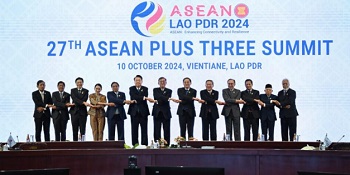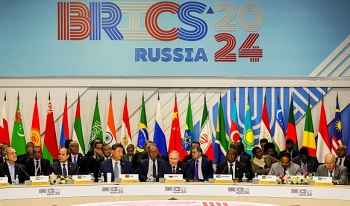International Affairs
 |
 |
 |
 |
 |
 |
 |
The End of Dollar Dominance
The global financial system is undergoing a seismic shift as nations increasingly
reject the U.S. dollar’s stranglehold on trade and reserves. From the BRICS alliance to ASEAN economies, a quiet revolution is unfolding – one that threatens to dismantle Washington’s economic weaponization of the dollar and replace it with a multipolar monetary framework. As sanctions backfire and trust in Western financial institutions erodes,
the world is turning to gold-backed currencies, regional trade settlements,
and a new BRICS reserve unit – potentially spelling the end of American financial hegemony.
Key points
For decades, the U.S. dollar reigned supreme as the world’s reserve currency, propped up by oil trade agreements and military dominance. But Washington’s reckless weaponization of the dollar –freezing Russian reserves, cutting nations off from SWIFT, and imposing unilateral sanctions – has backfired spectacularly. Now, nations are fleeing the greenback in droves.
 The ASEAN+3 bloc, representing some of the fastest-growing economies, has greenlit the Chiang Mai Initiative Multilateralisation (CMIM) Rapid Financing Facility, a bailout mechanism that bypasses the dollar entirely. Instead, it relies on the yuan and regional currencies – a direct challenge to IMF-dominated financial structures.
The ASEAN+3 bloc, representing some of the fastest-growing economies, has greenlit the Chiang Mai Initiative Multilateralisation (CMIM) Rapid Financing Facility, a bailout mechanism that bypasses the dollar entirely. Instead, it relies on the yuan and regional currencies – a direct challenge to IMF-dominated financial structures.
“Financial institutions from Europe and elsewhere are increasingly pitching yuan derivatives that cut out the U.S. currency,” a Singapore-based commodities trader told Bloomberg. European carmakers are fueling demand for euro-yuan hedges, while Indonesian banks are forming dedicated teams for rupiah-yuan transactions. The message is clear: the dollar is no longer indispensable.
BRICS & the rise of the R5
While ASEAN shifts toward regional currencies, the BRICS alliance (Brazil, Russia, India, China, South Africa) is crafting something far more ambitious – a new reserve currency to rival the dollar. Sergey Glazyev, Russia’s former economic advisor, confirmed the project is nearing completion, with the R5 (or R5+) emerging as a frontrunner.
The R5 would be backed by a basket of BRICS currencies – the real, ruble, rupee, renminbi, and rand – and could expand to include the Singapore dollar and UAE dirham. Yaroslav Lissovolik, a top Sberbank analyst, notes that the R5 could evolve into a settlement and reserve tool for emerging markets, reducing reliance on Western financial systems.
 But the real game-changer? Gold. Russia and Iran are developing a gold-backed digital currency for trade, rendering U.S. sanctions useless. Glazyev’s vision – dubbed Golden Ruble 3.0 – proposes pegging oil prices to gold (2 barrels per 1 gram), effectively creating a commodity-backed monetary standard.
But the real game-changer? Gold. Russia and Iran are developing a gold-backed digital currency for trade, rendering U.S. sanctions useless. Glazyev’s vision – dubbed Golden Ruble 3.0 – proposes pegging oil prices to gold (2 barrels per 1 gram), effectively creating a commodity-backed monetary standard.
“Fixing the price of oil in gold at the level of 2 barrels per 1g will give a second increase in the price of gold in dollars,” Glazyev wrote, echoing Credit Suisse strategist Zoltan Pozsar’s Bretton Woods III theory. The implications are staggering: if oil, gas, and minerals are traded in gold-backed currencies, the dollar’s dominance collapses overnight.
The petroyuan threat & the coming economic realignment
Saudi Arabia’s openness to non-dollar oil trade –long considered unthinkable – signals another death knell for dollar supremacy. “We will consider trading in currencies other than the U.S. dollar,” Finance Minister Mohammed al-Jadaan declared at Davos. If Riyadh shifts even a fraction of its oil sales to yuan, the petrodollar system crumbles.
Meanwhile, China and India are exploiting Western sanctions to resell discounted Russian energy at massive profits – while Europe’s industries, starved of affordable energy, relocate to Asia. “China is securing energy at discounts, not markups like Europe,” Pozsar observed, explaining why firms like BASF are shifting operations eastward.
The writing is on the wall: the Global South is uniting under a BRICS-led financial order, leaving the West isolated. As Indonesia’s president warned, nations must abandon Visa and Mastercard to avoid “geopolitical repercussions” like those imposed on Russia.
The dollar’s days as the world’s reserve currency are numbered. The only question is: How soon will the new system arrive?
This article was first published on
Chaos.News on May 12, 2025, under the title “The end of dollar dominance: BRICS and ASEAN nations forge new financial order amid DE-DOLLARIZATION surge”
Read other articles by Lance D. Johnson here

Key points
- ASEAN+3 nations have approved a yuan-based financial assistance mechanism, sidelining the dollar.
- BRICS is finalizing a new reserve currency, the R5, backed by a basket of member currencies and possibly gold.
- Russia and Iran are developing a gold-backed digital currency for trade, circumventing Western sanctions.
- Major economies like China, India, and Saudi Arabia are accelerating de-dollarization efforts.
- The petroyuan looms as Saudi Arabia considers non-dollar oil trade, threatening the petrodollar system.
For decades, the U.S. dollar reigned supreme as the world’s reserve currency, propped up by oil trade agreements and military dominance. But Washington’s reckless weaponization of the dollar –freezing Russian reserves, cutting nations off from SWIFT, and imposing unilateral sanctions – has backfired spectacularly. Now, nations are fleeing the greenback in droves.

Asian nations, including China, are uniting to leave the US dominated economic sphere
“Financial institutions from Europe and elsewhere are increasingly pitching yuan derivatives that cut out the U.S. currency,” a Singapore-based commodities trader told Bloomberg. European carmakers are fueling demand for euro-yuan hedges, while Indonesian banks are forming dedicated teams for rupiah-yuan transactions. The message is clear: the dollar is no longer indispensable.
BRICS & the rise of the R5
While ASEAN shifts toward regional currencies, the BRICS alliance (Brazil, Russia, India, China, South Africa) is crafting something far more ambitious – a new reserve currency to rival the dollar. Sergey Glazyev, Russia’s former economic advisor, confirmed the project is nearing completion, with the R5 (or R5+) emerging as a frontrunner.
The R5 would be backed by a basket of BRICS currencies – the real, ruble, rupee, renminbi, and rand – and could expand to include the Singapore dollar and UAE dirham. Yaroslav Lissovolik, a top Sberbank analyst, notes that the R5 could evolve into a settlement and reserve tool for emerging markets, reducing reliance on Western financial systems.

Russia & China are leading the BRICS coalition to form an anti-USA alternative economic system
“Fixing the price of oil in gold at the level of 2 barrels per 1g will give a second increase in the price of gold in dollars,” Glazyev wrote, echoing Credit Suisse strategist Zoltan Pozsar’s Bretton Woods III theory. The implications are staggering: if oil, gas, and minerals are traded in gold-backed currencies, the dollar’s dominance collapses overnight.
The petroyuan threat & the coming economic realignment
Saudi Arabia’s openness to non-dollar oil trade –long considered unthinkable – signals another death knell for dollar supremacy. “We will consider trading in currencies other than the U.S. dollar,” Finance Minister Mohammed al-Jadaan declared at Davos. If Riyadh shifts even a fraction of its oil sales to yuan, the petrodollar system crumbles.
Meanwhile, China and India are exploiting Western sanctions to resell discounted Russian energy at massive profits – while Europe’s industries, starved of affordable energy, relocate to Asia. “China is securing energy at discounts, not markups like Europe,” Pozsar observed, explaining why firms like BASF are shifting operations eastward.
The writing is on the wall: the Global South is uniting under a BRICS-led financial order, leaving the West isolated. As Indonesia’s president warned, nations must abandon Visa and Mastercard to avoid “geopolitical repercussions” like those imposed on Russia.
The dollar’s days as the world’s reserve currency are numbered. The only question is: How soon will the new system arrive?
Read other articles by Lance D. Johnson here
Posted May 16, 2025

______________________
______________________








